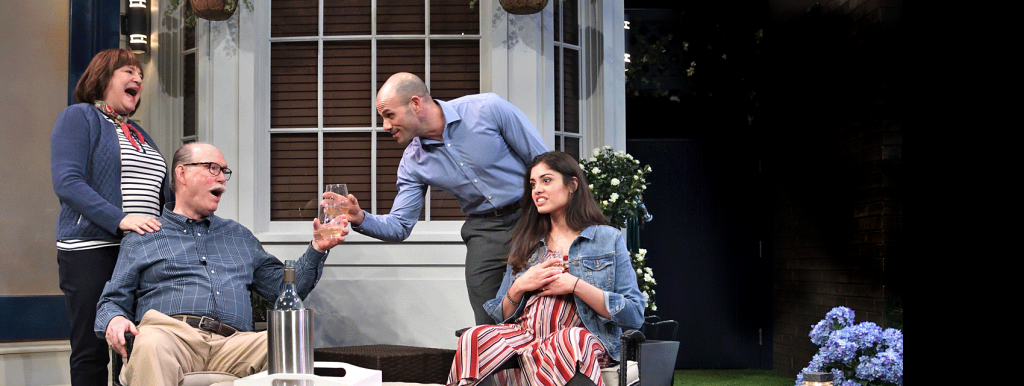Bringing 1970s Fashion to the Stage
Almost every piece of clothing you see in The Inferior Sex is genuine vintage.
We don’t mean vintage as in “clothes made today that look like they’re from 1972,” but as in most of the show’s shirts, pants, skirts, shoes, and purses were actually made and worn in the late 60s or early 70s.
Costume Shop Director Amanda Downing Carney designed the costumes for The Inferior Sex. While most Trinity Rep productions set in the past tend to recreate clothing in the style of the era, Amanda instead opted to source actual vintage garments. Her process included finding authentic pieces online through Etsy or specialty shops, as well as by thrifting at local shops. She said that she can often tell if a piece of clothing is genuine or not by its label, silhouette, and fabric. In 1972, fashion was filled to the brim with a durable new “wonder fabric: polyester.
“Because of how much from the 70s is polyester, I have so many options to choose from in terms of actual clothes that people wore in 1972 that are still in really good shape, sturdy enough to be worn on stage eight times a week, and washed multiple times a day,” Amanda said. “I usually hesitate to use vintage items in shows, but these are near-indestructible fabrics, so it made sense.”
In addition to polyester, fashion trends around 1972 included low-cut and wide-flare pants, pantsuits, ponchos, clogs, knits, and platform heels. Subcultures from the late 1960s such as mod and hippie styles carried over into the early 1970s as well. Many pieces featured busy patterns and bright colors.
“I started researching the time period and becoming a self-described amateur historian on 1972 fashion by looking at tons of patterns, advertisements, and photographs from the time so I can see what real people were wearing,” Amanda notes. “Then I read the play for lots of clues about who each character is, not just in terms of what the script tells us they’re wearing, but in terms of their background and personality. I keep that in mind when designing for each character. Because while they’re all in the same office in the same time period, in a lot of ways we do dress dissimilar from each other, especially when you’re working somewhere related to fashion.”
For example, Alice the photographer is old money, so her wardrobe consists of Ralph Lauren, neck ties, neutral tones, and the like.
Vera is the most mature character, so her fashion sense looks more polished and businesslike.
Penny is a working mom who opts for comfortable yet trendy pantsuits, while Sandra’s tastes lean toward pussycat bow blouses and A-line skirts, reflecting her conservative upbringing.
Food editor Madeleine has a wardrobe that is more girly and colorful, demonstrating her somewhat childish personality, compared to Joan, a practical character more interested in politics than fashion.
And finally, Gwen brings effortless style and casual sophistication to the office. While Connie wears her housekeeping uniform in many scenes, we soon learn that she just might be the most fashion-forward character in the entire show.
Most of The Inferior Sex characters change outfits frequently throughout the show. Amanda estimated that on average, most cast members change costumes at least six times in a performance.
Amanda couldn’t source time-specific vintage for every character though. For example, Shirley Chisholm is the only character in the play to be based on a real-life historical figure. Shirley’s outfits are recreations of some of her iconic looks: one from her campaign announcement, another from her speech at the Democratic National Convention, and finally, one from her concession speech. The costume shop handcrafted a wig to match Shirley’s iconic hairstyle and designed custom fabrics identical to patterns Shirley actually wore to sew together her costumes.
“Shirley was such an important, amazing, political figure that I think people don’t know enough about,” Amanda said. “That was one of the reasons I wanted to work on this show, since it’s been super fun to recreate her style.”
When designing period pieces, one major challenge includes balancing practicality with accuracy. And for any show, whether modern, period, or fantasy, costumes need to work together with other parts of the production to build the overall aesthetic.
“Everything is so bright, and there were so many patterns, so it’s challenging trying to balance each person’s look for the stage, especially when all nine cast members are onstage,” Amanda noted. “And while it’s ultimately orchestrated by the director, Tatyana, the looks need to work with the set and lighting design so as to not overwhelm. And since we have some choreography in the play, we need to make sure these are costumes actors can move in.”
Ultimately, recreating historical looks on stage can pose a colorful challenge. History doesn’t preserve itself in a complete state. So it’s up to the storyteller to piece together what might have been, whether through words, photos, fabric, or design. We wonder if in a few decades, theaters will repurpose the clothes we’re wearing right now for what would then be period pieces set in the 2020s!

